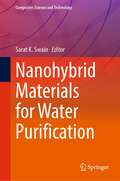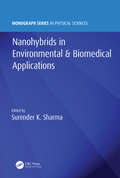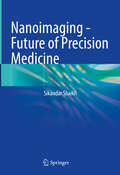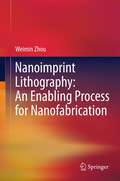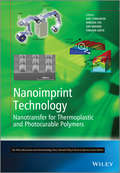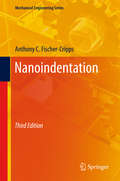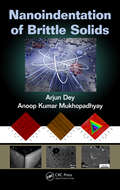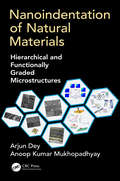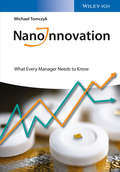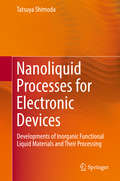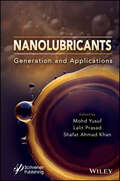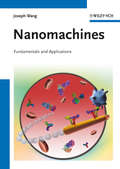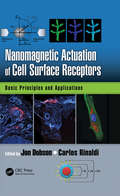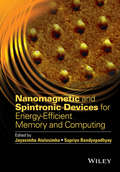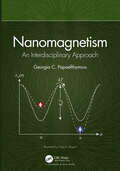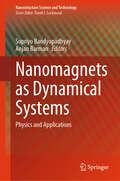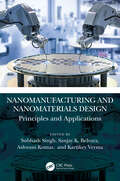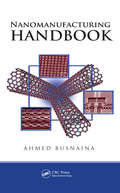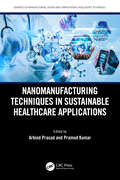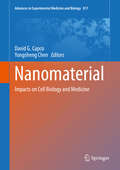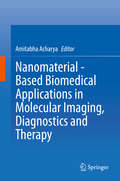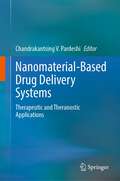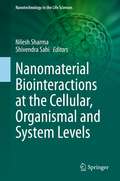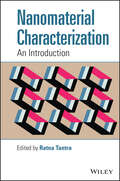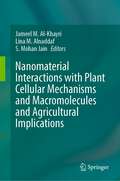- Table View
- List View
Nanohybrid Materials for Water Purification (Composites Science and Technology)
by Sarat K. SwainThis book comprehensively reviews the key topics in the area of nanocomposites and hybrid materials used for waste water treatment and purification. It covers materials chemistry, various synthesis approaches and properties of these nanomaterials for the different water purification techniques. It provides new direction to the readers to better understand the chemistry behind these materials and the methods to improve their properties. This book will be a very valuable reference source for graduates and postgraduates, engineers, research scholars (primarily in the field of material science, water, nanoscience and nanotechnology), material scientists, researchers in the water-related area, scientists working in water treatment plans and pollution mitigation industries.
Nanohybrids in Environmental & Biomedical Applications (Monograph Series in Physical Sciences)
by Surender Kumar SharmaHeterostructured nanoparticles have the capability for a broad range of novel and enhanced properties, which leads to appealing biomedical and environmental applications. This timely new book addresses the design and preparation of multiphase nanomaterials with desired size, shape, phase composition, and crystallinity, as well as their current applications. It emphasizes key examples to motivate deeper studies, including nanomaterial-based hyperthermia treatment of cancer, nanohybrids for water purification, nanostructures used in the removal or detection of bioagents from waste water, and so on. Features Presents state of the art research on heterostructured nanomaterials, from their synthesis and physiochemical properties to current environmental and biological applications. Includes details on toxicity and risk assessment of multifunctional nanomaterials. Discusses recent developments and utilization in healthcare by leading experts. Introduces the main features of functionalization of nanomaterials in terms of desired size, shape, phase composition, surface functionalization/coating, toxicity, and geometry. Emphasizes practical applications in the environmental and biomedical sectors.
Nanoimaging - Future of Precision Medicine
by Sikandar ShaikhThe book covers all the aspects of the advances in nanoimaging. It provides a step-by-step overview of the various aspects of nanoimaging from the basics like nanoparticle production. It describes the different applications of nanoparticles across multiple imaging modalities and their applications in oncology, cardiology, neurology, infection and inflammation and many other conditions. The book also covers the detailed use of the different modalities like ultrasound, CT, MRI, PET-CT, PET-MRI, and nuclear medicine for various conditions. It describes various nanoparticles, nano biomarkers and nanoprobes used for multiple applications. Several chapters provide detailed information on the molecular level. Additionally, the book discusses nano theranostics - a newer concept used in molecular imaging for diagnosing the disease and its therapeutic purpose. It provides basic and detailed information on the use of nanoimaging in various conditions and pathologies along with therapeutic options. The book is helpful for residents, fellows, students and various specialists, such as radiologists, molecular imaging specialists, molecular biologists, oncologists, hematologists, surgeons, biomedical engineers, and various specialities involving the use of nanoimaging.
Nanoimprint Lithography: An Enabling Process for Nanofabrication
by Weimin ZhouNanoimprint Lithography: An enabling process for nanofabrication presents a comprehensive description of nanotechnology that is one of the most promising low-cost, high-throughput technologies for manufacturing nanostructures, and an emerging lithography candidates for 22, 16 and 11 nm nodes. It provides the exciting, multidisciplinary field, offering a wide range of topics covering: principles, process, material and application. This book would be of specific interest for researchers and graduate students in the field of nanoscience, nanotechnology and nanofabrication, material, physical, chemical, electric engineering and biology. Dr. Weimin Zhou is an associate professor at Shanghai Nanotechnology Promotion Center, China.
Nanoimprint Technology: Nanotransfer for Thermoplastic and Photocurable Polymers (Microsystem and Nanotechnology Series (ME20))
by Jun Taniguchi Hiroshi Ito Jun Mizuno Takushi SaitoNanoscale pattern transfer technology using molds is a rapidly advancing area and one that has seen much recent attention due to its potential for use in nanotechnology industries and applications. However, because of these rapid advances, it can be difficult to keep up with the technological trends and the latest cutting-edge methods. In order to fully understand these pioneering technologies, a comprehensive understanding of the basic science and an overview of the techniques are required. Nanoimprint Technology: Nanotransfer for Thermoplastic and Photocurable Polymers covers the latest nanotransfer science based on polymer behaviour. Polymer fluid dynamics are described in detail, and injection moulding, nanoimprint lithography and micro contact printing are also discussed. Cutting-edge nanotransfer technologies and applications are also considered and future trends in industry are examined. Key features: • Covers the fundamentals of nanoimprint technology • Presents cutting-edge techniques and applications • Provides industrial examples and describes the mold fabrication process • Considers nanotransfer of thermoplastics by simulation • Describes the design and evaluation of UV curable polymer Nanoimprint Technology: Nanotransfer for Thermoplastic and Photocurable Polymers is a comprehensive reference for industry engineers as well as graduate and undergraduate students, and is a useful source of information for anyone looking to improve their understanding of nanotransfer mechanisms and methods.
Nanoindentation
by Anthony C. Fischer-CrippsNanoindentation, Third Edition gives a detailed account of the most up-to-date research in this important field of materials testing. As in previous editions, extensive theoretical treatments are provided and explained in a clear and consistent manner that will satisfy both experienced and novice scientists and engineers. Additionally, numerous examples of the applications of the technique are provided directly from manufacturers of nanoindentation instruments. A helpful series of appendices provides essential reference information that includes a list of frequently asked questions. The new edition has been restructured to provide results of the latest research and developments in the field of mechanical testing while retaining the essential background and introductory, but authoritative nature, of the previous editions. The new edition also expands on the instrumentation and applications chapters by including material sourced direct from the instrument manufacturers in this field. Aimed at graduate student level, this book is designed to fill a need associated with the use of nanoindentation as a quantitative test method for mechanical properties of small volumes of materials.
Nanoindentation of Brittle Solids
by Arjun Dey Anoop Kumar MukhopadhyayUnderstanding the Basics of Nanoindentation and Why It Is ImportantContact damage induced brittle fracture is a common problem in the field of brittle solids. In the case of both glass and ceramics-and as it relates to both natural and artificial bio-materials-it has triggered the need for improved fabrication technology and new product development
Nanoindentation of Natural Materials: Hierarchical and Functionally Graded Microstructures
by Arjun Dey Anoop Kumar MukhopadhyayNanoindentation of Natural Materials: Hierarchical and Functionally Graded Microstructures provides a systematic introduction and review of state-of-the-art statistical hierarchical and functionally graded structures found in bone, teeth, hair, and scales, from a nanoindentation perspective, including detailed microstructure and composition. It covers the basics of hierarchical and functionally graded structures and nanoindentation techniques and detailed discussion with correlation micro/nano mechanical-structures The book includes practical issues backed with experimental data
NanoInnovation
by Michael TomczykThe innovative, easy-to-read guide to the "nanoscale revolution", this book provides essential knowledge of nanotechnology and clearly explains the fundamentals of nanomaterials and properties.Written by a technology pioneer, the book shows feasible strategies for managers in nanotech companies, including how to communicate with nanotech engineers and developers, coupled with examples of emerging technologies and innovations. A level-headed discussion of critical issues for decision makers and stakeholders rounds off the contents.The result is a vivid, yet realistic look at nanotechnology, providing orientation in the nanoworld: major lines of research, key players in R&D, as well as social, economic and political issues.
Nanoliquid Processes for Electronic Devices: Developments of Inorganic Functional Liquid Materials and Their Processing
by Tatsuya ShimodaThis book summarizes the results of the research on how to make small electronic devices with high properties by using simple liquid processes such as coating, self-assembling and printing, especially focusing on devices composed of silicon and oxide materials. It describes syntheses and analyses of solution materials, formations of solid thin films from solutions, newly developed patterning methods to make devices, and characterization of the developed devices. In the first part of the book, the research on liquid silicon (Si) materials is described. Because the use of a liquid material is a quite new idea for Si devices, this book is the first one to describe liquid Si materials for electronic devices. Si devices as typified by MOS-FET have been produced by using solid and gas materials. This volume precisely describes a series of processes from material synthesis to device fabrication for those who are interested and are/will be engaged in liquid Si-related work. In the latter part of the book, a general method of how to make good oxide films from solutions and a new imprinting method to make nanosized patterns are introduced. For making oxide films with high quality, the designing of the solution is crucial. If a solution is designed properly, a gel material called "cluster gel" can be formed which is able to be imprinted to form nanosized patterns. The anticipated readers of this book are researchers, engineers, and students who are interested in solution and printing processes for making devices. More generally, this book will also provide guidelines for corporate managers and executives who are responsible for making strategies for future manufacturing processes.
Nanolubricants: Generation and Applications
by Mohd Yusuf Lalit Prasad Shafat Ahmad KhanNANOLUBRICANTS Through the dissemination of the latest advancements in nanolubrication science, this volume addresses the pressing concerns surrounding their economic feasibility, environmental acceptability, sustainability, and overall viability. Lubrication is the lifeblood of machinery and the key to its smooth operation. In the world of mechanics and engineering, the role of lubricants cannot be overstated. They are the unsung heroes that reduce friction between surfaces in contact, thus preventing excessive heat generation during motion. Beyond this primary function, lubricants find their application in diverse areas, including power transmission, foreign object transportation, and the regulation of surface temperature. In recent times, the world has shifted towards sustainable and environmentally-friendly practices, prompting a transition from conventional lubricants to more efficient and eco-conscious alternatives. Among these emerging solutions, nanolubricants have emerged as formidable contenders, reshaping the landscape of lubrication technology. Their adoption not only promises enhanced performance but also carries the added benefit of environmental responsibility through biodegradability. This book delves into the multifaceted realm of nanolubricants, exploring their characterization and application across various domains. From vegetable oil-based lubricants to those incorporating metal and non-metal oxide components, this comprehensive work encompasses nine meticulously curated chapters. A particular focus is placed on the intriguing synergy between nano-dimensionality and the incorporation of metals and metal oxides into vegetable oil-based biodegradable lubricants. The book explores the environmental advantages, progress, and challenges associated with this innovative approach. Furthermore, it delves into the integration of functionalized nanostructured semi-metal-based compounds as lubricant additives in non-edible vegetable oils, paving the way for improved tribological properties. Audience The book is extremely important to industrial practitioners working in mechanical engineering, tribology, wear, tear, friction and lubrication behavior of machinery. Researchers in nanoscience, nanotechnology, materials science, and sustainability subjects, will find this book useful.
Nanomachines
by Joseph WangNanomachines represent one of the most fascinating topics in of nanotechnology. These tiny devices provide diverse opportunities towards a wide range of important applications, ranging from targeted delivery of drug payloads to environmental remediation. This book addresses comprehensively the latest developments and discoveries in the field of nano- and microscale machines. It covers the evolution of nanomachines in general from a historical perspective, the fundamental challenges for motion at the nanoscale, different categories of biological and synthetic nano/microscale motors based on different propulsion mechanisms, ways for controlling the movement directionalityand regulated speed, followed by detailed of major areas for which nanomachines has the potential to make a transformational impact. It ends with a futuristic look at nano/microscale machines and into their impact on the society.Key Features:* The only nanomachine introductory textbook currently available.* Written with college graduate level in mind to appeal to a broad interdisciplinary audience.* Covers the fundamental challenges for nanoscale motion.* Covers the latest advances in the design and operaton of a wide range of small-scale machines.* Covers diverse biomedical, environmental and technological applications of nanomachines.* Written in review format with cited articles to cover latest research and developments.
Nanomagnetic Actuation in Biomedicine: Basic Principles and Applications
by Jon Dobson Carlos RinaldiThe manipulation and control of cells and sub-cellular structures through magnetic nanoparticle-based actuation is a relatively new technique that has led to novel and exciting biomedical applications. Nanomagnetic actuation is being used in laboratory studies of stem cells to determine how these mechanical cues can be used to control stem cell differentiation for regenerative medicine applications. This book explores this rapidly expanding field. It will interest industry bioscientists and biomedical engineers as well as academics in cellular biomechanics, cell and tissue engineering, and regenerative medicine. Key Features Focuses on the fundamentals and applications of magnetic actuation Includes contributions by world-class researchers from several countries and is edited by a well-known researcher in this field Offers multidisciplinary coverage and applications Supplies extensive references at the end of each chapter
Nanomagnetic and Spintronic Devices for Energy-Efficient Memory and Computing
by Supriyo Bandyopadhyay Jayasimha AtulasimhaNanomagnetic and spintronic computing devices are strong contenders for future replacements of CMOS. This is an important and rapidly evolving area with the semiconductor industry investing significantly in the study of nanomagnetic phenomena and in developing strategies to pinpoint and regulate nanomagnetic reliably with a high degree of energy efficiency. This timely book explores the recent and on-going research into nanomagnetic-based technology. Key features: Detailed background material and comprehensive descriptions of the current state-of-the-art research on each topic. Focuses on direct applications to devices that have potential to replace CMOS devices for computing applications such as memory, logic and higher order information processing. Discusses spin-based devices where the spin degree of freedom of charge carriers are exploited for device operation and ultimately information processing. Describes magnet switching methodologies to minimize energy dissipation. Comprehensive bibliographies included for each chapter enabling readers to conduct further research in this field. Written by internationally recognized experts, this book provides an overview of a rapidly burgeoning field for electronic device engineers, field-based applied physicists, material scientists and nanotechnologists. Furthermore, its clear and concise form equips readers with the basic understanding required to comprehend the present stage of development and to be able to contribute to future development. Nanomagnetic and Spintronic Devices for Energy-Efficient Memory and Computing is also an indispensable resource for students and researchers interested in computer hardware, device physics and circuits design.
Nanomagnetism: An Interdisciplinary Approach
by Georgia C. PapaefthymiouNanomagnetism: An Interdisciplinary Approach provides a core foundation for understanding magnetic quantum-size effects at the nanoscale and their many applications across the disciplines. This textbook will be a valuable guide for students in new interdisciplinary courses in nanomagnetism and magnetic nanomaterials, an area that has experienced immense growth in the last two decades due to advancements in sample preparation, nanopatterning techniques and magnetic measurement instrumentation. The interdisciplinary nature of nanoscience also makes this book an ideal resource for scientists working in industrial laboratories and pharmaceutical and medical researchers looking to expand their understanding of the physics of magnetic probes. Key Features Discusses physical, chemical and nanotemplating synthesis techniques for the production of magnetic nanoparticles Covers experimental techniques for the determination of the macroscopic and microscopic magnetization of nanoparticles Discusses the role of nanomagnetism in high-density magnetic recording media, nanostructured permanent magnets, MRI imaging enhancement and magnetically guided drug delivery
Nanomagnets as Dynamical Systems: Physics and Applications (Nanostructure Science and Technology)
by Supriyo Bandyopadhyay Anjan BarmanThis contributed volume provides a comprehensive overview of contemporary advancements in the field of nanomagnetism and spintronics. It covers a diverse range of topics, including the static and dynamic responses of designer nanomagnets, spin wave dynamics in ultra-thin ferromagnetic films, voltage-controlled magnetic anisotropy, magneto-elastic control of nanomagnet dynamics, mutual synchronization in spintronic oscillators, magnetic droplet solitons, and the applications of voltage-controlled magnetic anisotropy in spintronic devices. Each chapter discusses specific aspects of these subjects, exploring theoretical models, experimental methods, applications, and future directions, making it an essential resource for researchers, students, and professionals in the fields of physics, materials science, electrical engineering and nanonscience.
Nanomanufacturing and Nanomaterials Design: Principles and Applications
by Subhash Singh Sanjay K. Behura Ashwani Kumar Kartikey VermaNanomanufacturing includes bottom-up or top-down techniques, each of which gives an advanced, reliable, scaled-up, and economical methods in the production of nanomaterials. The text discusses fundamental concepts, advanced topics, and applications of nanomanufacturing in a comprehensive manner. Features Discussion of the design and fabrication of nano- and micro-devices in a comprehensive manner. Covers nanofabrication techniques for photovoltaics applications. Lists constitutive modelling and simulation of multifunctional nanomaterials. Introduces nanomanufacturing of nanorobots and their industrial applications. Presents nanomanufacturing of a high-performance piezoelectric nanogenerator for energy harvesting. Important topics include nanomanufacturing of high-performance piezoelectric nanogenerators for energy harvesting, nanosensor, nanorobots, nanomedicine, nano diagnostic tools, 3D nano printing, additive nanomanufacturing of functional materials for human‐integrated smart wearables, and nanofabrication techniques. Nanomanufacturing and Nanomaterials Design covers the latest applications of nanomanufacturing for a better understanding of the concepts. The text provides scientific and technological insights on novel routes of design and fabrication of few-layered nanostructures and their heterostructures based on a variety of advanced materials. It will be a valuable resource for senior undergraduate, graduate students and researchers in the fields of mechanical, manufacturing, industrial, production engineering and materials science.
Nanomanufacturing Handbook
by Ahmed BusnainaBreakthroughs in nanotechnology have been coming at a rapid pace over the past few years. This was fueled by significant worldwide investments by governments and industry. But if these promising young technologies cannot begin to show commercial viability soon, that funding is in danger of disappearing as investors lose their appetites and the economic and scientific promise of nanotechnology may not be realized. Scrutinizing the barriers to commercial scale-up of nanotechnologies, the Nanomanufacturing Handbook presents a broad survey of the research being done to bring nanotechnology out of the laboratory and into the factory. Current research into nanotechnology focuses on the underlying science, but as this forward-looking handbook points out, the immediate need is for research into scale-up, process robustness, and system integration issues. Taking that message to heart, this book collects cutting-edge research from top experts who examine such topics as surface-programmed assembly, fabrication and applications of single-walled carbon nanotubes (SWNTs) including nanoelectronics, manufacturing nanoelectrical contacts, room-temperature nanoimprint and nanocontact technologies, nanocontacts and switch reliability, defects and surface preparation, and other innovative, application-driven initiatives. In addition to these technical issues, the author provides a survey of the current state of nanomanufacturing in the United States—the first of its kind—and coverage also reaches into patenting nanotechnologies as well as regulatory and societal issues. With timely, authoritative coverage accompanied by numerous illustrations, the Nanomanufacturing Handbook clarifies the current challenges facing industrial-scale nanotechnologies and outlines advanced tools and strategies that will help overcome them.
Nanomanufacturing Techniques in Sustainable Healthcare Applications (Advances in Manufacturing, Design and Computational Intelligence Techniques)
by Arbind Prasad and Pramod KumarThe text begins by discussing the processing and characterization of nano-manufactured resorbable bionanocomposites and presents the latest advances in carbon-based polymer nanocomposite materials for sensing applications. It further presents different characterization techniques such as scanning electron, transmission electron, atomic force microscopy, and powder X-ray diffraction for the identification of bionanocomposites.This book:• Introduces nano-manufactured processed composites for biomedical application, processing, and characterization of bionanocomposites.• Presents biobased nano-manufactured processed composites for imaging, tissue repairing, and drug-delivery applications.• Explains future trends of nano-manufactured composites in 3D bio-implants and fluorescent bioimaging.• Highlights the challenges and perspectives of polymeric nano-manufactured composites for biomedical applications.• Covers multifunctional nano-manufactured bio-composites, and advances in polymeric membranes for healthcare applications.It is primarily written for senior undergraduates, graduate students, and academic researchers in the fields of manufacturing engineering, biomedical engineering, materials science and engineering, mechanical engineering, and production engineering.
Nanomaterial
by David G. Capco Yongsheng ChenThe rapidly developing field of nanomaterials has expanded in many commercial areas. More recent studies have begun to provide a foundation for understanding how nanomaterials influence cells and how they also can serve as methodological tools for studies in medicine and cell biology, including research into stem cells. Recent investigations have shown affects of nanomaterials on specific subcellular structures, such as the actin-based brush border network in cells with an increasing emphasis on the barrier function of epithelial tissues. While other studies have shown involvement of nanoparticles in specific cytoplasmic signal transduction events such as the rise in intracellular free calcium, a signaling event known to regulate many changes in cell architecture and function. In parallel, nanomaterials are increasingly used in medicine for drug delivery, treatment of cancer and an increasing number of new applications. This book investigates these areas and also includes new methods for assessment in cell biology and medicine.
Nanomaterial - Based Biomedical Applications in Molecular Imaging, Diagnostics and Therapy
by Amitabha AcharyaThis book comprehensively reviews the recent advances in nanomaterial-based molecular imaging, diagnostics, and personalized therapy. It discusses the novel biocompatible fluorescent nanomaterials, their synthesis, and modern state of art characterization, as well as the various strategies for immobilization of biomacromolecules on the nanomaterial surface and approaches for increasing their stability. In addition, the book describes the synthesis of lectin nanoconjugates using different types of biocompatible raw materials and their systematic characterization. Lastly, it presents our current understanding of the biomolecular carona, which affects nanoparticle-based targeted drug delivery, and examines the conceptual approaches to improve the in-vivo efficacy of targeted drug delivery.
Nanomaterial-Based Drug Delivery Systems: Therapeutic and Theranostic Applications
by Chandrakantsing V. PardeshiEffective drug delivery systems are essential in maximizing the therapeutic effects of the drugs in question. This book thoroughly analyses recent technological advances in new, nanomaterial-based drug delivery systems for the diagnosis and treatment of various diseases. These systems also have diverse applications in pharmaceutical, biomedical, biomaterial, and biotechnological fields. This book explains the different types of nanocarriers currently in development and covers both therapeutic and theranostic applications of drug-loaded nanocarriers and nanomedicine.Clinical research professionals, industrial pharmaceutical scientists, and veteran drug delivery developers benefit from the unique structure of this book, making it essential for the drug delivery researcher. Students, research scholars, and industrial professionals alike benefit from the current technological advancements, regulatory aspects, and the history of discovery and development in the field of nanomedicine presented in this book.
Nanomaterial Biointeractions at the Cellular, Organismal and System Levels (Nanotechnology in the Life Sciences)
by Nilesh Sharma Shivendra SahiThe range of nanomaterial applications has expanded recently from catalysis, electronics, and filtration to therapeutics, diagnostics, agriculture, and food because of unique properties and potentials of different nanoparticles and nanomaterials. Research shows that these exquisite particles can interact with an organism at the cellular, physiological, biochemical, and molecular levels. However, our knowledge of how they affect these changes, selectively or generally, in diverse organism or ecosystems is very limited and far from satisfactory. Data indicate that the biological function largely depends on the shape, size, and surface characteristics of the nanoparticles used besides life cycle stages of an organism. Therefore, this compilation will focus on the body of work carried out by distinguished investigators using diverse nanomaterials and plant and animal species. This book includes specific case studies as well as general review articles highlighting aspects of multilayered interactions, and targets not only research and academic scholars but also the concerned industry and policy makers as well.
Nanomaterial Characterization: An Introduction
by Ratna TantraIntroduces basic knowledge for nanomaterial characterization focusing on key properties and the different analytical techniques available Provides a quick reference to different analytical methods for a given property highlighting their pros and cons Presents numerous case studies, ranging from characterizing nanomaterials in coffee creamer suspension to measurement of airborne dust exposure levels Provides an introduction to other topics that are strongly related to nanomaterial characterization e.g. synthesis, reference material and metrology Includes state of the art techniques: scanning tunneling microscopy under extreme conditions, novel strategy for biological characterization and methods to visualize multidimensional characterization data
Nanomaterial Interactions with Plant Cellular Mechanisms and Macromolecules and Agricultural Implications
by S. Mohan Jain Jameel M. Al-Khayri Lina M. AlnaddafThis book focuses on the recent progress of nanotechnology with emphasis on the interaction between nanoparticles and plants on the cellular level. It is devoted to understanding the pathways of nanomaterials entry into plant cell and their influence on cellular organelle processes and influence on crop yield. It consists of 16 chapters grouped in 3 parts: Part I Cellular mechanisms, Part II Cellular macromolecules, and Part III Implications of nanomaterials. Chapters present the plant response to nanomaterial applications including morphological, physiochemical, and anatomical changes and their effect on plant growth and productivity. The book discusses the mechanisms of absorbance and translocation of nanoparticles and their interaction with the plant cellular biochemical compounds and organelles. It presents the current perspective of nanomaterials influence on cellular processes which include photosynthesis, photorespiration and pigment synthesis and accumulation. In addition, it provides current understanding of the impact of nanomaterials on cellular macromolecules including carbohydrates, lipids, nucleic acids, proteins, hormones, and antioxidant defense activities. Collectively, these processes and biochemical compounds have implications on crop yield. Chapters are written by globally recognized scientists and subjected to a rigorous review process to ensure quality presentation and scientific precision. Chapter begins with an introduction that covers similar contexts and includes a detailed discussion of the topic accompanied by high-quality color images, diagrams, and relevant details and concludes with recommendations for future study directions.Chapter "Impact of Nanomaterials on Plant Secondary Metabolism" is available open access under a Creative Commons Attribution 4.0 International License via link.springer.com.
